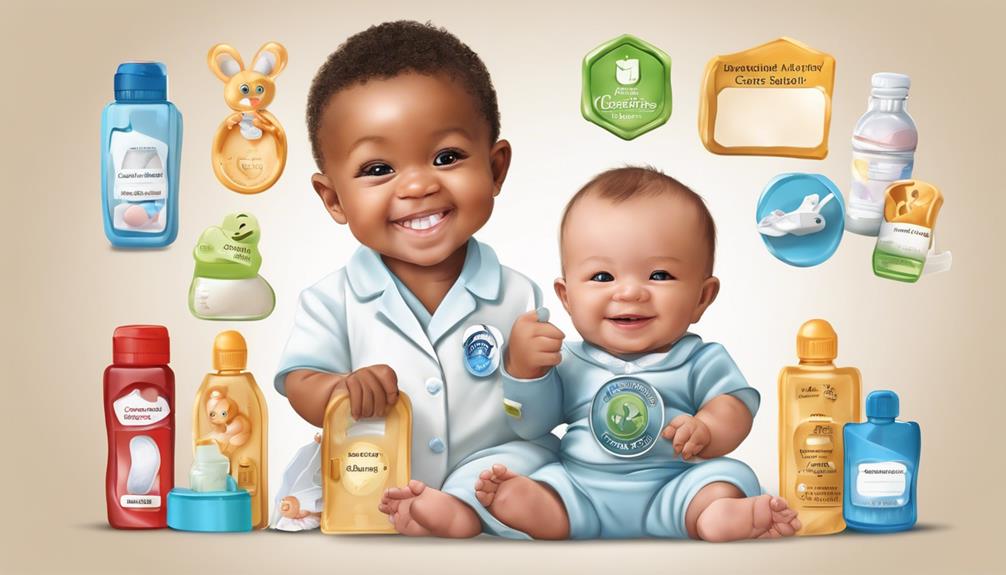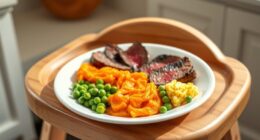When it comes to soothing hiccups in your newborn, the saying 'an ounce of prevention is worth a pound of cure' rings true.
You may have tried a few methods, but are you aware of all the ways to ease those tiny hiccups?
Stay tuned to discover a variety of gentle and effective techniques that can bring relief to your little one and peace of mind to you.
Key Takeaways
- Burping techniques after feeding release excess gas and aid digestion.
- Pacifiers relax the diaphragm and distract from hiccups.
- Proper feeding positions prevent air swallowing and reduce hiccups.
- Creating a calm environment enhances soothing and digestion for the newborn.
Gentle Burping Techniques
To help ease your newborn's hiccups, employing gentle burping techniques after each feeding is important.
Burping is an essential step in releasing excess gas in your baby's stomach, a common trigger for those adorable little hiccups. By burping your baby after every 2-3 ounces of formula or when switching breasts during breastfeeding, you can help prevent hiccups from interrupting their comfort and relaxation.
Proper burping techniques involve holding your baby upright against your chest and gently patting or rubbing their back in a soothing motion. This method not only aids in reducing the air swallowed during feeding but also promotes better digestion and overall well-being for your little one.
Offer a Pacifier
Consider offering your newborn a pacifier to help ease and potentially stop their hiccups. Pacifiers can work wonders by relaxing the diaphragm and regulating your baby's breathing pattern, which in turn aids in hiccup relief.
The gentle sucking action on the pacifier provides a soothing effect that may distract your baby from the discomfort of hiccups, offering a calming and comforting experience. This non-invasive method is safe and gentle, making it a popular choice among parents for addressing hiccups in newborns.
Change Feeding Positions

Adjusting feeding positions can be beneficial in alleviating hiccups in your newborn by improving their posture during feeding. Here's how different feeding positions can help reduce hiccups:
- Upright Position: Holding your baby in an upright position while feeding can prevent them from swallowing excess air, which in turn may reduce the occurrence of hiccups.
- Side-Lying Position: Trying a side-lying position during feeding can aid in digestion and provide a comfortable alternative that may help alleviate hiccups.
- Semi-Upright Position: Opting for a semi-upright position can also be effective in promoting smoother swallowing and minimizing hiccups by allowing gravity to assist in the digestion process.
Experimenting with various feeding positions, such as reclined or sitting upright, can help you find the most suitable and comfortable feeding position for your baby. Remember, proper positioning is key to preventing air swallowing and reducing hiccups during feeding time.
Provide a Calm Environment

Creating a serene environment during feedings is essential for reducing stress and preventing hiccups in your newborn. To provide a calm environment, make sure the feeding area is a quiet and peaceful space. Minimize distractions and loud noises that could unsettle your baby.
Maintaining an important temperature is vital; keep the room neither too hot nor too cold to help prevent hiccups. Use soft lighting or dim the lights during feedings to create a soothing atmosphere that aids in digestion. Avoid sudden movements that might startle your baby and disrupt the feeding process.
Try Skin-to-Skin Contact

Skin-to-skin contact with your newborn not only helps regulate their body temperature and heart rate but also fosters a strong emotional bond between you and your baby. This intimate practice offers numerous benefits that can positively impact both you and your little one:
- Regulate Body Temperature: Skin-to-skin contact provides a warm and stable environment for your newborn, helping them maintain an ideal body temperature.
- Promote Bonding: The closeness shared during skin-to-skin contact enhances emotional well-being and strengthens the bond between you and your baby.
- Reduce Stress and Soothe Hiccups: This comforting technique has been shown to reduce stress for both you and your baby, effectively calming a fussy newborn and soothing hiccups.
Engaging in skin-to-skin contact not only creates a nurturing environment but can also improve breastfeeding success and enhance milk production. Embrace this beautiful practice as a special way to connect with your newborn and provide them with the care and comfort they need.
Gently Rock or Pat Your Baby

When your newborn is experiencing hiccups, gently rocking or patting them can help relax their diaphragm and encourage the hiccups to subside.
The rhythmic motion created by rocking or patting provides a soothing distraction for your baby, helping them feel comforted during this moment.
This physical interaction not only aids in diverting your baby's attention from the hiccups but also promotes relaxation, easing any discomfort they may be feeling.
The gentle touch and movement can create a calming environment, allowing your baby to feel secure and reassured.
By engaging in rocking or patting, you aren't only soothing your baby but also facilitating the relaxation of their diaphragm, potentially leading to a decrease in the hiccups.
Consult a Healthcare Provider

Seeking guidance from a healthcare provider is essential if your newborn's hiccups persist or are accompanied by other concerning symptoms. Consulting a healthcare provider can provide you with the professional guidance needed to address your newborn's specific needs effectively and safely. Here's why consulting a healthcare provider is vital:
- Personalized Advice: Healthcare providers can offer personalized advice and recommendations tailored to your newborn's specific needs and medical history.
- Assessment of Underlying Issues: They can assess whether the hiccups are a normal occurrence or if they signify an underlying issue that requires attention.
- Reassurance and Support: Healthcare providers not only help address the hiccups but also provide reassurance and support, offering peace of mind for parents.
Frequently Asked Questions
How Do You Stop Hiccups in Newborns?
To stop hiccups in newborns, you can try burping them, offering a pacifier, changing their position, or gently rubbing their back. Avoid risky remedies like holding their breath. These methods can help relieve hiccups and comfort your little one.
Is It OK to Lay Baby Down With Hiccups?
You can lay your baby down with hiccups; it's safe and won't harm them. Hiccups are common and harmless in newborns. If your baby is uncomfortable, try gentle soothing techniques to ease their hiccups.
What Positions Help Newborn With Hiccups?
When your newborn has hiccups, try holding them upright or over your shoulder while patting their back. Experiment with reclined positions and keep them calm. Different approaches work for different babies, so find what soothes yours best.
Do Hiccups Mean Baby Is Full?
Hiccups in your newborn do not necessarily mean they are full. They are more often caused by diaphragm irritation, feeding pace, air intake, or spasms. Burping during and after feedings can help prevent hiccups.
Conclusion
To summarize, soothing your newborn's hiccups can be easily done with gentle burping, a pacifier, and creating a calm environment. Remember to consult with your healthcare provider if hiccups persist.
Trust in these simple yet effective methods to bring comfort to your little one. Let love and patience guide you as you navigate this journey of caring for your newborn.









